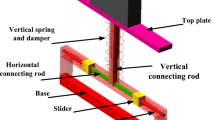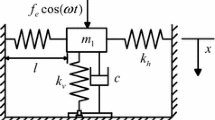Abstract
To enhance the low-frequency vibration isolation performance of the high-static–low-dynamic stiffness (HSLDS) isolator, a novel design of the geometric nonlinear damping (GND) comprising semi-active electromagnetic shunt damping is proposed. The GND is dependent on the vibration displacement and velocity, which can make the HSLDS isolator attain different damping characteristics in different frequency bands. Firstly, the configuration of the HSLDS isolator assembled with GND is presented, and then the restoring force, stiffness, and damping are derived. The dynamics of the mount under both base and force excitations are investigated based on the harmonic balance method, which are then verified by numerical simulations. After that, the effects of GND on the displacement and force transmissibility are studied, and the excellent performance caused by GND is analyzed based on the equivalent viscous damping mechanism. Finally, the comparison between the GND and cubic nonlinear damping is performed. The results demonstrate that the HSLDS isolator assembled with GND can realize the requirements of an isolation system under both base and force excitations of broadband vibration isolation performance and a low resonance peak with the high-frequency attenuation unaffected. Moreover, the GND outperforms the linear damping no matter the base excitation or force excitation is applied. For base excitation, the GND exhibits some desirable properties that the cubic nonlinear damping does not have at high frequencies.






















Similar content being viewed by others
Abbreviations
- GND:
-
Geometric nonlinear damping
- EMSD:
-
Electromagnetic shunt damping
- HSLDS:
-
High-static–low-dynamic stiffness
- QZS:
-
Quasi-zero stiffness
- NSM:
-
Negative stiffness mechanisms
- DVDD:
-
Displacement–velocity-dependent damping
- SFS:
-
Spiral flexure spring
- MNSS:
-
Magnetic negative stiffness spring
- MNS:
-
Magnetic negative stiffness
- ED:
-
Electromagnetic devices
- ENIC:
-
External negative impedance circuits
References
Rivin, E.I.: Passive vibration isolation. Appl. Mech. Rev. 57(6), B31–B32 (2004)
Thomson, W.: Theory of Vibration with Applications. CRC Press, Boca Raton (1996)
Alabuzhev, P.M., Rivin, E.I.: Vibration Protecting and Measuring Systems with Quasi-Zero Stiffness. Hemisphere Pub. Corp, Washington (1989)
Carrella, A., Brennan, M.J., Waters, T.P., Lopes, V.: Force and displacement transmissibility of a nonlinear isolator with high-static--low-dynamic-stiffness. Int. J. Mech. Sci. 55(1), 22–29 (2012). https://doi.org/10.1016/j.ijmecsci.2011.11.012
Carrella, A., Brennan, M.J., Waters, T.P.: Static analysis of a passive vibration isolator with quasi-zero-stiffness characteristic. J. Sound Vib. 301(3–5), 678–689 (2007). https://doi.org/10.1016/j.jsv.2006.10.011
Carrella, A., Brennan, M.J., Kovacic, I., Waters, T.P.: On the force transmissibility of a vibration isolator with quasi-zero-stiffness. J. Sound Vib. 322(4–5), 707–717 (2009). https://doi.org/10.1016/j.jsv.2008.11.034
Xu, D.L., Zhang, Y.Y., Zhou, J.X., Lou, J.J.: On the analytical and experimental assessment of the performance of a quasi-zero-stiffness isolator. J. Vib. Control 20(15), 2314–2325 (2014). https://doi.org/10.1177/1077546313484049
Platus, D.L.: Negative-stiffness-mechanism vibration isolation systems. In: Derby, E.A., Gordon, C.G., Vukobratovich, D., Yoder, P.R., Zweben, C. (eds.) Optomechanical Engineering and Vibration Control, Proceedings of the Society of Photo-Optical Instrumentation Engineers (Spie), vol. 3786, pp. 98–105. Spie-International Society for Optical Engineering, Bellingham (1999)
Huang, X.C., Liu, X.T., Sun, J.Y., Zhang, Z.Y., Hua, H.X.: Vibration isolation characteristics of a nonlinear isolator using Euler buckled beam as negative stiffness corrector: a theoretical and experimental study. J. Sound Vib. 333(4), 1132–1148 (2014). https://doi.org/10.1016/j.jsv.2013.10.026
Liu, X.T., Huang, X.C., Hua, H.X.: On the characteristics of a quasi-zero stiffness isolator using Euler buckled beam as negative stiffness corrector. J. Sound Vib. 332(14), 3359–3376 (2013). https://doi.org/10.1016/j.jsv.2012.10.037
Huang, X.C., Liu, X.T., Hua, H.X.: Effects of stiffness and load imperfection on the isolation performance of a high-static--low-dynamic-stiffness non-linear isolator under base displacement excitation. Int. J. Non Linear Mech. 65, 32–43 (2014). https://doi.org/10.1016/j.ijnonlinmec.2014.04.011
Huang, X.C., Liu, X.T., Sun, J.Y., Zhang, Z.Y., Hua, H.X.: Effect of the system imperfections on the dynamic response of a high-static--low-dynamic stiffness vibration isolator. Nonlinear Dyn. 76(2), 1157–1167 (2014). https://doi.org/10.1007/s11071-013-1199-7
Carrella, A., Brennan, M.J., Waters, T.P., Shin, K.: On the design of a high-static--low-dynamic stiffness isolator using linear mechanical springs and magnets. J. Sound Vib. 315(3), 712–720 (2008). https://doi.org/10.1016/j.jsv.2008.01.046
Robertson, W.S., Kidner, M.R.F., Cazzolato, B.S., Zander, A.C.: Theoretical design parameters for a quasi-zero stiffness magnetic spring for vibration isolation. J. Sound Vib. 326(1–2), 88–103 (2009). https://doi.org/10.1016/j.jsv.2009.04.015
Xu, D.L., Yu, Q.P., Zhou, J.X., Bishop, S.R.: Theoretical and experimental analyses of a nonlinear magnetic vibration isolator with quasi-zero-stiffness characteristic. J. Sound Vib. 332(14), 3377–3389 (2013). https://doi.org/10.1016/j.jsv.2013.01.034
Wu, W.J., Chen, X.D., Shan, Y.H.: Analysis and experiment of a vibration isolator using a novel magnetic spring with negative stiffness. J. Sound Vib. 333(13), 2958–2970 (2014). https://doi.org/10.1016/j.jsv.2014.02.009
Dong, G.X., Zhang, X.N., Xie, S.L., Yan, B., Luo, Y.J.: Simulated and experimental studies on a high-static--low-dynamic stiffness isolator using magnetic negative stiffness spring. Mech. Syst. Signal Process. 86, 188–203 (2017). https://doi.org/10.1016/j.ymssp.2016.09.040
Zhou, N., Liu, K.: A tunable high-static--low-dynamic stiffness vibration isolator. J. Sound Vib. 329(9), 1254–1273 (2010). https://doi.org/10.1016/j.jsv.2009.11.001
Ravindra, B., Mallik, A.K.: Hard Duffing-type vibration isolator with combined Coulomb and viscous damping. Int. J. Non Linear Mech. 28(4), 427–440 (1993). https://doi.org/10.1016/0020-7462(93)90017-F
Ho, C., Lang, Z.Q., Billings, S.A.: A frequency domain analysis of the effects of nonlinear damping on the Duffing equation. Mech. Syst. Signal Process. 45(1), 49–67 (2014). https://doi.org/10.1016/j.ymssp.2013.10.027
Ho, C., Lang, Z.Q., Billings, S.A.: Design of vibration isolators by exploiting the beneficial effects of stiffness and damping nonlinearities. J. Sound Vib. 333(12), 2489–2504 (2014). https://doi.org/10.1016/j.jsv.2014.02.011
Peng, Z.K., Meng, G., Lang, Z.Q., Zhang, W.M., Chu, F.L.: Study of the effects of cubic nonlinear damping on vibration isolations using harmonic balance Method. Int. J. Non Linear Mech. 47(10), 1073–1080 (2012). https://doi.org/10.1016/j.ijnonlinmec.2011.09.013
Laalej, H., Lang, Z.Q., Daley, S., Zazas, I., Billings, S.A., Tomlinson, G.R.: Application of non-linear damping to vibration isolation: an experimental study. Nonlinear Dyn. 69(1–2), 409–421 (2012). https://doi.org/10.1007/s11071-011-0274-1
Milovanovic, Z., Kovacic, I., Brennan, M.J.: On the displacement transmissibility of a base excited viscously damped nonlinear vibration isolator. J. Vib. Acoust. 131(5), 054502 (2009). https://doi.org/10.1115/1.3147140
Tang, B., Brennan, M.J.: A comparison of two nonlinear damping mechanisms in a vibration isolator. J. Sound Vib. 332(3), 510–520 (2013). https://doi.org/10.1016/j.jsv.2012.09.010
Freischlag, J.A., Lawrence, P.F., Perler, B.A.: The Society for Vascular Surgery will participate in a new global vascular practice guidelines initiative. J. Sound Vib. 59(2), 510–510 (2014). https://doi.org/10.1016/j.jvs.2013.12.025
Sun, X.T., Jing, X.J.: Analysis and design of a nonlinear stiffness and damping system with a scissor-like structure. Mech. Syst. Signal Process. 66–67, 723–742 (2016). https://doi.org/10.1016/j.ymssp.2015.05.026
Sun, X.T., Xu, J., Jing, X.J., Cheng, L.: Beneficial performance of a quasi-zero-stiffness vibration isolator with time-delayed active control. Int. J. Mech. Sci. 82, 32–40 (2014). https://doi.org/10.1016/j.ijmecsci.2014.03.002
Xu, J., Sun, X.T.: A multi-directional vibration isolator based on Quasi-Zero-Stiffness structure and time-delayed active control. Int. J. Mech. Sci. 100, 126–135 (2015). https://doi.org/10.1016/j.ijmecsci.2015.06.015
Huang, X.C., Sun, J.Y., Hua, H.X., Zhang, Z.Y.: The isolation performance of vibration systems with general velocity–displacement-dependent nonlinear damping under base excitation: numerical and experimental study. Nonlinear Dyn. 85(2), 777–796 (2016). https://doi.org/10.1007/s11071-016-2722-4
Rahim, M.A., Waters, T.P., Rustighi, E.: Active damping control for vibration isolation of high-static--low-dynamic-stiffness isolators. In: Proceedings of International Conference on Noise and Vibration Engineering (ISMA2014) and International Conference on Uncertainty in Structural Dynamics (USD2014), pp. 173–186 (2014)
Cheng, C., Li, S.M., Wang, Y., Jiang, X.X.: Force and displacement transmissibility of a quasi-zero stiffness vibration isolator with geometric nonlinear damping. Nonlinear Dyn. 87(4), 2267–2279 (2017). https://doi.org/10.1007/s11071-016-3188-0
Yan, B., Luo, Y.J., Zhang, X.N.: Structural multimode vibration absorbing with electromagnetic shunt damping. J. Vib. Control 22(6), 1604–1617 (2016). https://doi.org/10.1177/1077546314543809
Yan, B., Zhang, X.N., Luo, Y.J., Zhang, Z.F., Xie, S.L., Zhang, Y.H.: Negative impedance shunted electromagnetic absorber for broadband absorbing: experimental investigation. Smart Mater. Struct. 23(12), 11 (2014). https://doi.org/10.1088/0964-1726/23/12/125044
Zhang, X.N., Niu, H.P., Yan, B.: A novel multimode negative inductance negative resistance shunted electromagnetic damping and its application on a cantilever plate. J. Sound Vib. 331(10), 2257–2271 (2012). https://doi.org/10.1016/j.jsv.2011.12.028
Niu, H.P., Zhang, X.N., Xie, S.L., Wang, P.P.: A new electromagnetic shunt damping treatment and vibration control of beam structures. Smart Mater. Struct. 18(4), 15 (2009). https://doi.org/10.1088/0964-1726/18/4/045009
Ravaud, R., Lemarquand, G., Electromagnetics, A.: Analytical expressions of the magnetic field created by tile permanent magnets of various magnetization directions. In: Piers 2009 Moscow Vols I and II, Proceedings. Electromagnetics Acad, Cambridge (2009)
Kovacic, I., Brennan, M.J.: The Duffing Equation: Nonlinear Oscillators and Their Behaviour. Wiley, New York (2011)
Acknowledgements
This work is supported by the National Natural Science Foundation of China Academy of Engineering Physics and jointly set up “NSAF” joint fund (Grant No. U1630120).
Author information
Authors and Affiliations
Corresponding author
Appendix
Appendix
The integral expressions \(\varPhi _{1}\), \(\varPhi _{2}\), \(\varPhi _{3}\), and \(\varPhi _{4}\) in Eqs. (1–2) are given as follows:
where r(i) denotes the inner and outer radii of ring-shaped magnets with \(r(1)=r_{\mathrm{in}1}\) and \(r(2)=r_{\mathrm{out}1}\). The locations of top and bottom faces of moving magnet in inertial coordinate are represented with \(z(1)=z-h_{1}/2\) and \(z(2) =z-h_{1}/2\), separately.
Rights and permissions
About this article
Cite this article
Dong, G., Zhang, Y., Luo, Y. et al. Enhanced isolation performance of a high-static–low-dynamic stiffness isolator with geometric nonlinear damping. Nonlinear Dyn 93, 2339–2356 (2018). https://doi.org/10.1007/s11071-018-4328-5
Received:
Accepted:
Published:
Issue Date:
DOI: https://doi.org/10.1007/s11071-018-4328-5




